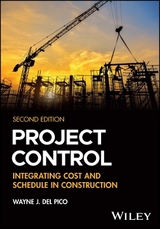
Project Control
R.S. Means Company Ltd (Verlag)
978-1-118-13923-3 (ISBN)
- Titel erscheint in neuer Auflage
- Artikel merken
WAYNE J. DEL PICO, CPE, is President of W. J. Del Pico, Inc., which provides construction management, litigation support services for construction-related matters, and construction education. He has more than thirty years of experience in construction project management and estimating and has been involved in projects throughout the United States. His professional experience includes private commercial construction, public construction, retail construction, and residential land development and construction.
Foreword xiii About the Author xv Introduction xvii 1 The Basics 1 The Concept of Project Management 1 History of Project Management 2 Approaches to Project Management 3 The Traditional Approach 4 The Initiating Process 4 The Planning Process 5 The Executing Process 6 The Monitoring and Controlling Process 6 The Closing Process 7 Benefits of Proper Planning 8 The Role of the Project Manager 9 Lead the Project Team 10 Create the Project Plan 10 Develop the Project Schedule 11 Monitor the Progress of the Project 11 Control the Project 12 Take Corrective Action 12 Achieve the Project Goals 12 Goals of the Project 12 Contractual Performance Obligations 13 Financial Objectives 13 Prevent or Minimize Delay 13 Avoid Claims or Litigation 14 Control the O?]P?]C Relationship 14 Increase Market Share 14 Role of the Contract Documents 15 Study the Plans and Specifications 15 Identify Discrepancies Early 16 Visit the Project Site 16 Understand the Project Constraints 16 Determine Potential Problem Areas 17 Understand Contract Procedures 17 The Schedule and Budget 18 Summary 18 2 Introduction to Project Control 19 Overview of Project Control 19 Project Control Terminology 21 Project Control Formulas 30 The Project Control Cycle 30 Plan to Achieve Goals 31 Execute Work According to Plan 32 Measure the Progress 32 Identify Variations 32 Analyze Cause of Variations 32 Implement Corrective Actions 33 Execute Work and Measure Changes 33 Summary 34 3 Pre?]Construction Planning 35 Initiating the Control Process 35 Pre?]Construction Planning 36 Key Personnel and Responsibilities 38 The Contractor s Group 38 The Design Professional s Group 42 Owner s Group 43 Regulatory Group 44 The Plan the Roadmap 45 Establishing a Baseline for Schedule Control 47 Establishing a Baseline for Cost Control 48 The Communication Plan 49 Summary 50 4 The Schedule 53 Basic Scheduling Concepts 53 Types of Schedules 54 The Checklist 54 The Schedule Board 56 The Bar Chart 56 The Look Ahead 57 The Linear Schedule 57 Advanced Scheduling Methods 58 Program Evaluation and Review Technique 58 Critical Path Method (CPM) 59 The CPM Schedule as a Management Tool 59 Tasks 60 The Work Breakdown Structure 60 Task Types 61 Task Descriptions 63 Task Durations 63 Interdependencies 67 Complex Relationships Lags and Leads 68 Milestones and Constraints 70 Float 71 Updating the Schedule 72 Summary 73 5 The Budget 75 Fundamentals of the Estimating Process 75 Types of Estimates 77 Organization of Estimates 77 The Budget 83 Deconstructing the Estimate to Build the Budget 87 Project Cost Report 91 The Budget as a Management Tool 91 Summary 92 6 Integrating the Schedule and the Budget 93 Schedule of Values 93 Matching Cost Values to Tasks 96 Planned vs. Actual Values 99 Summary 102 7 Calculating and Analyzing Progress 103 Measuring Performance 103 Units Completed 103 Incremental Milestone 104 Start/Finish 105 Cost Ratio 105 Experience/Opinion 105 Weighted or Equivalent Units 106 Earned Value 107 Fixed Budget Approach 107 Variable Budget Approach 108 Choosing a Fixed or Variable Approach 109 Schedule and Cost Performance 110 Summary 114 8 Analyzing and Reporting Variances in Schedule and Cost 115 Understanding Project Analyses 115 S?]Curves 115 Tracking Gantt Chart 120 Control Charts 121 SPI and CPI Charts 122 Causes of Variances 123 Cost Variances 124 Schedule Variances 124 Variance Thresholds 125 Root Cause Analysis 127 Reporting Project Status 129 Summary 132 9 Recognizing Trends and Forecasting Performance 133 Recognizing Trends 133 Using Trends to Forecast 136 Estimate at Completion 136 Estimate to Complete 137 Variance at Completion 138 To?]Complete Performance Index 138 Project Percentage Analysis 140 Summary 141 10 Productivity 143 Understanding Productivity 143 Productivity Index 144 Factors Affecting Construction Productivity 145 Controllable Factors Affecting Productivity 146 Uncontrollable Factors Affecting Productivity 146 Recommendations for Improving Productivity 147 Summary 148 11 Acceleration and Schedule Compression 149 Acceleration 149 Actual Acceleration 150 Constructive Acceleration 150 Forced Acceleration 151 Schedule Compression 152 Time?]Cost Trade?]off Analysis 153 Time?]Cost Trade?]off Concepts 154 Recovery Schedule 158 Summary 159 12 Resource Management 161 Resources 161 Resource Allocation 162 Resource Management 163 Resource Profile 164 Splitting Tasks 166 Material Management 167 Material Management in Practice 168 Summary 169 13 Risk Management 171 Components of Risk Management 171 Risk Identification 172 Risk Assessment 172 Risk Response Plan 175 Risk Response Control 177 Risk Contingency Planning 178 Contingency Plan Funding 178 Probability Analysis 179 Contract Modifications and Impact on Risk 186 Summary 187 14 Project Closeout 189 Initiation of Project Closeout 189 Objectives of the Closeout Process 190 Contract Closeout 191 Administrative Closeout 192 Archiving Project Files 192 Lessons Learned Meeting 193 Lessons Learned Documentation 194 Project Closeout Report 195 Summary 195 Appendix A Practice Review Questions 197 Appendix B Answers to Practice Review Questions 205 Index 215
| Erscheint lt. Verlag | 18.10.2013 |
|---|---|
| Reihe/Serie | RSMeans |
| Verlagsort | Kingston |
| Sprache | englisch |
| Maße | 191 x 234 mm |
| Gewicht | 408 g |
| Themenwelt | Technik ► Architektur |
| Technik ► Bauwesen | |
| Technik ► Maschinenbau | |
| ISBN-10 | 1-118-13923-2 / 1118139232 |
| ISBN-13 | 978-1-118-13923-3 / 9781118139233 |
| Zustand | Neuware |
| Informationen gemäß Produktsicherheitsverordnung (GPSR) | |
| Haben Sie eine Frage zum Produkt? |
aus dem Bereich



